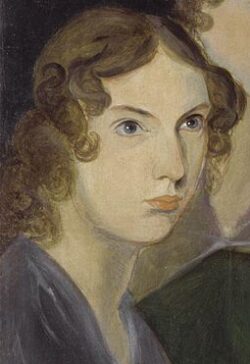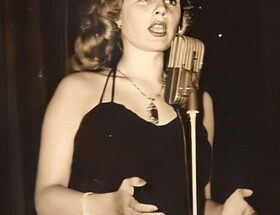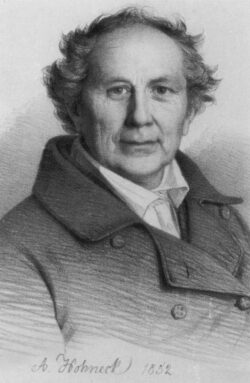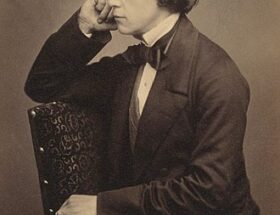
Early Life
Anne was born on 17 January 1820 on the outskirts of Bradford, where her father Patrick worked as curate, and was the youngest of the Brontë children. Anne was baptised there on 25 March 1820.
Patrick was appointed to the perpetual curacy in Haworth, a small town seven miles (11 km) away and n April 1820 the family moved into the five-roomed Haworth Parsonage.
When Anne was barely a year old her mother, Maria Branwell, became ill, probably with uterine cancer and died on 15 September 1821. Patrick tried to remarry, but without success.
Maria’s sister, Elizabeth Branwell, had moved to the parsonage initially to care for Maria but spent the rest of her life there raising Maria’s children.
Elizabeth did this due to duty and was described as a stern woman who expected respect, not love. There was little affection between her and the older children but according to tradition Anne was her favourite.
In the summer of 1824 Patrick sent his daughters Maria, Elizabeth, Charlotte and Emily to Crofton Hall in Crofton, West Yorkshire, and subsequently to the Clergy Daughter’s School at Cowan Bridge in Lancashire.
Maria and Elizabeth Brontë died of consumption on 6 May and 15 June 1825 respectively, and Charlotte and Emily were immediately brought home. The unexpected deaths distressed the family so much that Patrick couldn’t bring himself to send them away again. They were educated at home for the next five years, largely by Elizabeth Branwell and Patrick.
The children made little attempt to mix with others outside the parsonage and relied on each other for company. The bleak moors surrounding Haworth became their playground. Anne shared a room with her aunt Elizabeth and were close, which may have influenced Anne’s personality and religious beliefs.
Education
Anne’s studies at home included music and drawing. The Keighley church organist gave piano lessons to Anne, Emily and Branwell while John Bradley of Keighley gave them art lessons. Each child drew with some skill.
Their aunt tried to teach the girls how to run a household, but they were more inclined to literature. They read much from their father’s well-stocked library which included the Bible, Homer, Virgil, Shakespeare, Milton, Byron, Scott, articles from Blackwood’s Edinburgh Magazine and Fraser’s Magazine and The Edinburgh Review, and miscellaneous books of history and geography and biography.
Their reading fed their imaginations and their creativity soared after their father gave Branwell a set of toy soldiers in June 1826. They gave names to the soldiers (or the “Twelves”) and developed their characters.
This led to the creation of an imaginary world: the African kingdom of “Angria”, which was illustrated with maps and watercolour renderings. The children devised plots about the inhabitants of Angria and its capital city, “Glass Town”, later called Verreopolis or Verdopolis.
Their fantastical worlds and kingdoms gradually acquired characteristics from their historical world, drawing from its sovereigns, armies, heroes, outlaws, fugitives, inns, schools, and publishers. The characters and lands created by the children were given newspapers and magazines and chronicles written in tiny books with writing so small that it was difficult to read without a magnifying glass. These creations and writings were an apprenticeship for their later literary talents.
Teenaged Years
Around 1831, when Anne was eleven, she and Emily broke away from Charlotte and Branwell to create and develop their own fantasy world, “Gondal”. Anne and Emily were particularly close, especially after Charlotte left for Roe Head School in January 1831.
Charlotte’s friend Ellen Nussey visited Haworth in 1833 and reported that Emily and Anne were “like twins” and “inseparable companions”. She described Anne so:
Anne, dear gentle Anne was quite different in appearance from the others, and she was her aunt’s favourite. Her hair was a very pretty light brown and fell on her neck in graceful curls. She had lovely violet-blue eyes; fine pencilled eyebrows and a clear almost transparent complexion. She still pursued her studies and especially her sewing, under the surveillance of her aunt.
Anne took lessons from Charlotte after she returned from Roe Head. Charlotte returned to Roe Head as a teacher on 29 July 1835, accompanied by Emily as a pupil. Emily’s tuition was largely financed by Charlotte’s teaching.
Emily was unable to adapt to life at school and was physically ill from homesickness within a few months. She was withdrawn from school by October and replaced by Anne.
Anne was 15 and it was her first time away from home. She made few friends at Roe Head. She was quiet, hardworking and determined to stay to acquire the education which she would need to support herself. She stayed for two years and returned home only during Christmas and summer holidays. She also won a good-conduct medal in December 1836.
Charlotte’s letters almost never mention Anne while Anne was at Roe Head, which might imply that they were not close, but Charlotte was at least concerned about Anne’s health. By December 1837 Anne had become seriously ill with gastritis and embroiled in religious crisis.
A Moravian minister was called to see her several times during her illness, suggesting her distress was caused, in part, by conflict with the local Anglican clergy. Charlotte wrote to their father and he brought Anne home.
Employment at Blake Hall
A year after leaving the school, and aged 19, Anne was seeking a teaching position. Her father had no private income and the parsonage would revert to the church on his death. Teaching or working as a governess were among few options for a poor and educated woman. In April 1839 Anne started work as a governess for the Ingham family at Blake Hall, near Mirfield.
The children in her charge were spoiled and disobedient. Anne had great difficulty controlling them and little success in educating them. She was not allowed to punish them, and when she complained about their behaviour she received no support and was criticised for being incapable. The Inghams were dissatisfied with their children’s progress and dismissed Anne.
She returned home in 1839 at Christmas. At home also were Charlotte and Emily, who had left their positions, and Branwell. Anne’s time at Blake Hall was so traumatic that she reproduced it in almost perfect detail in her novel Agnes Grey.
Meeting William Weightman
Anne returned to Haworth and met William Weightman, her father’s new curate who had started work in the parish in August 1839. Weightman was 25 and had obtained a two-year licentiate in theology from the University of Durham.
Anne’s acquaintance with him parallels her writing a number of poems, which may suggest she fell in love with him although there is disagreement over this possibility. Little evidence exists beyond a teasing anecdote of Charlotte’s to Ellen Nussey in January 1842.
In Agnes Grey Agnes’ interest in the curate refreshes her interest in poetry. Outside fiction William Weightman aroused much curiosity. It seems that he was good-looking and engaging, and that his easy humour and kindness towards the sisters made an impression. It is such a character that she portrays in Edward Weston, and that her heroine Agnes Grey finds deeply appealing.
If Anne was attracted to Weightman it does not mean that he was attracted to her. It is possible that Weightman was no more aware of her, her sisters or their friend Ellen Nussey. Nor does it imply that Anne believed him to be interested in her.
If anything, her poems suggest the opposite–they speak of quietly experienced but intensely felt emotions, hidden from others, without any indication of being requited. It is possible that an initially mild attraction to Weightman assumed increasing importance to Anne over time in the absence of other opportunities for love, marriage and children.
Anne would have seen Weightman on her holidays at home, particularly during the summer of 1842 when her sisters were away. Unfortunately, he died of cholera in the same year.
Anne expressed her grief for his death in her poem I will not mourn thee, lovely one, in which she called him “our darling”.
Governess
From 1840 to 1845 Anne worked at Thorp Green Hall, a comfortable country house near York. Here she was governess to the children of the Reverend Edmund Robinson and his wife, Lydia. The house appeared as Horton Lodge in Agnes Grey.
Anne had four pupils: Lydia (15), Elizabeth (13), Mary (12) and Edmund (8). She initially had problems similar to those at Blake Hall. Anne missed her home and family.
In a diary paper in 1841 she wrote that she did not like her situation and wished to leave it. Her quiet and gentle disposition did not help. But Anne was determined and made a success of her position, becoming well-liked by her employers. Her charges, the Robinson girls, became lifelong friends.
Anne spent only five or six weeks a year with her family, during holidays at Christmas and in June. The rest of her time was spent with the Robinsons. She accompanied the Robinsons on annual holidays to Scarborough.
Between 1840 and 1844 Anne spent around five weeks each summer at the coastal town which she loved and used a number of locations in Scarborough for her novels.
Anne and her sisters considered setting up a school while she was still working for the Robinsons. Various locations were considered, including the parsonage, but the project never materialised.
Anne came home on the death of her aunt in early November 1842 while her sisters were in Brussels. Elizabeth Branwell left a £350 legacy (equivalent to £30,000 in 2019) for each of her nieces.
It was at the Long Plantation at Thorp Green in 1842 that Anne wrote her three-verse poem Lines Composed in a Wood on a Windy Day, which was published in 1846 under the name Acton Bell.
In January 1843 Anne returned to Thorp Green and secured a position for Branwell. He was to tutor Edmund, who was growing too old to be in Anne’s care. Branwell did not live in the house as Anne did.
Anne’s vaunted calm appears to have been the result of hard-fought battles, balancing deeply felt emotions with careful thought, a sense of responsibility and resolute determination.
All three Brontë sisters worked as governesses or teachers, and all experienced problems controlling their charges, gaining support from their employers, and coping with homesickness, but Anne was the only one who persevered and made a success of her work.
Return to the parsonage
Anne and Branwell taught at Thorp Green for the next three years. Branwell entered into a secret relationship with his employer’s wife, Lydia Robinson. When Anne and Branwell returned home for the holidays in June 1846 Anne resigned.
She gave no reason, but her decision could be influenced by the relationship between her brother and Mrs Robinson. Branwell was later dismissed when his employer found out about the relationship.
Despite the outcome, Anne continued to exchange letters with Elizabeth and Mary Robinson and the two girls came to visit Anne in December 1848.
Anne took Emily to visit some of the places which Anne had become fond of. A plan to visit Scarborough fell through, but they went to York and saw York Minster.
A book of poems
The Brontës were at home with their father during the summer of 1845. None had any immediate prospect of employment. Charlotte found Emily’s poems, which had been shared only with Anne and said that they should be published.
Anne showed her own poems to Charlotte, and Charlotte “thought that these verses too had a sweet sincere pathos of their own”. The sisters eventually reached an agreement and told nobody what they were doing. With the money from Elizabeth Branwell they paid for publication of a collection of poems, 21 from Anne and 21 from Emily and 19 from Charlotte.
The book was published under pen names which retained their initials but concealed their gender. Anne’s pseudonym was Acton Bell. Poems by Currer, Ellis, and Acton Bell was available for sale in May 1846. The cost of publication was about three-quarters of Anne’s salary at Thorp Green.
On 7 May 1846 the first three copies were delivered to Haworth Parsonage. The book achieved three somewhat favourable reviews, but was a commercial failure, with only two copies sold in the first year. Anne nonetheless found a market for her later poetry.
The Leeds Intelligencer and Fraser’s Magazine published her poem The Narrow Way under her pseudonym in December 1848. Four months earlier, Fraser’s Magazine had published her poem The Three Guides.
”Agnes Grey”
By July 1846 a package containing the manuscripts of each sister’s first novel was making the rounds of London publishers. Charlotte had written The Professor, Emily had written Wuthering Heights, and Anne had written Agnes Grey.
After some rejections Wuthering Heights and Agnes Grey were accepted by the publisher Thomas Cautley Newby while The Professor was rejected altogether.
It was not long before Charlotte had completed her second novel, Jane Eyre. Jane Eyre was accepted immediately by Smith, Elder & Co.. It was the first published of the sisters’ novels, and an immediate and resounding success.
Meanwhile Anne and Emily’s novels “lingered in the press”. Anne and Emily were obliged to pay fifty pounds to help meet their publishing costs. Their publisher was galvanised by the success of Jane Eyre and published Wuthering Heights and Agnes Grey together in December 1847. They sold well, but Agnes Grey was outshone by Emily’s more dramatic Wuthering Heights.
The Tenant of Wildfell Hall
Anne’s second novel, The Tenant of Wildfell Hall, was published in the last week of June 1848. It was an instant and phenomenal success, and sold out within six weeks.
The Tenant of Wildfell Hall is perhaps amongst the most shocking of contemporary Victorian novels as Anne’s depictions of alcoholism and debauchery were profoundly disturbing to 19th-century sensibilities.
It is easy to underestimate the extent to which the novel challenged the social and legal structures. In 1913 May Sinclair said that the slamming of Helen Huntingdon’s bedroom door against her husband reverberated throughout Victorian England.
In the book Helen has left her husband to protect their son from his influence. She supports herself and her son in hiding by painting. She has violated social conventions and English law. Until the Married Women’s Property Act 1870 was passed, a married woman had no legal existence independent from her husband and could not own property nor sue for divorce nor control the custody of her children.
Helen’s husband had a right to reclaim her and charge her with kidnapping. By subsisting on her own income she was stealing her husband’s property since this income was legally his.
Anne stated her intentions in the second edition, published in August 1848. She presented a forceful rebuttal to critics (among them Charlotte) who considered her portrayal of Huntingdon overly graphic and disturbing. Anne explained that:
When we have to do with vice and vicious characters, I maintain it is better to depict them as they really are than as they would wish to appear. To represent a bad thing in its least offensive light is doubtless the most agreeable course for a writer of fiction to pursue; but is it the most honest, or the safest? Is it better to reveal the snares and pitfalls of life to the young and thoughtless traveller, or to cover them with branches and flowers? O Reader! if there were less of this delicate concealment of facts – this whispering ‘Peace, peace’, when there is no peace, there would be less of sin and misery to the young of both sexes who are left to wring their bitter knowledge from experience.
Anne also castigated reviewers who speculated on the sex of authors and the perceived appropriateness of their writing. She was satisfied with the notion that
If a book is a good one, it is so whatever the sex of the author may be. All novels are or should be written for both men and women to read, and I am at a loss to conceive how a man should permit himself to write anything that would be really disgraceful to a woman, or why a woman should be censured for writing anything that would be proper and becoming for a man.
London Visit
In July 1848 Anne and Charlotte went to Charlotte’s publisher George Smith in London to dispel the rumour that the “Bell brothers” were one person. Emily refused to go. Anne and Charlotte spent several days with Smith.
Many years after Anne’s death, he wrote in the Cornhill Magazine his impressions of her:
A gentle, quiet, rather subdued person, by no means pretty, yet of a pleasing appearance. Her manner was curiously expressive of a wish for protection and encouragement, a kind of constant appeal which invited sympathy.
The increasing popularity of the Bells’ works led to renewed interest in Poems by Currer, Ellis, and Acton Bell, originally published by Aylott and Jones. The remaining print run was bought by Smith and Elder, and reissued under new covers in November 1848 but it still sold poorly.
Family Tragedy
Branwell’s persistent drunkenness disguised the decline of his health and he died on 24 September 1848, aged 31. His sudden death shocked the family. The cause was recorded as chronic bronchitis – marasmus, but was probably tuberculosis.
The family suffered from coughs and colds during the winter of 1848, and Emily became very ill. She worsened over two months and rejected medical aid until the morning of 19 December.
She was very weak and said that “if you will send for a doctor, I will see him now”. But Emily died at about two o’clock that afternoon, aged 30.
Emily’s death deeply affected Anne. Her grief undermined her physical health. Over Christmas Anne had influenza. Her symptoms intensified and in early January her father sent for a Leeds physician. The doctor diagnosed advanced consumption with little hope of recovery.
Anne met the news with characteristic determination and self-control. However, in her letter to Ellen Nussey she expressed her frustrated ambitions:
I have no horror of death: if I thought it inevitable I think I could quietly resign myself to the prospect … But I wish it would please God to spare me not only for Papa’s and Charlotte’s sakes but because I long to do some good in the world before I leave it. I have many schemes in my head for future practise – humble and limited indeed – but still I should not like them all to come to nothing, and myself to have lived to so little purpose. But God’s will be done.
Unlike Emily, Anne took all the recommended medicines and followed the advice she was given. That same month she wrote her last poem, A dreadful darkness closes in, in which she deals with being terminally ill. Her health fluctuated for months, but she grew thinner and weaker.
Death
Anne seemed somewhat better in February. She decided to visit Scarborough to see if the change of location and the fresh sea air might benefit her. Charlotte was initially against the journey, fearing that it would be too stressful, but changed her mind after the doctor’s approval and Anne’s assurance that it was her last hope.
On 24 May 1849 Anne set off for Scarborough with Charlotte and Ellen Nussey. They spent a day and night in York en route. Here they escorted Anne in a wheelchair and did some shopping and visited York Minster. It was clear that Anne had little strength left.
On Sunday 27 May Anne asked Charlotte whether it would be easier to return home and die instead of remaining in Scarborough. A doctor was consulted the next day and said that death was close. Anne received the news quietly.
She expressed her love and concern for Ellen and Charlotte, and whispered for Charlotte to “take courage”. Anne died at about two o’clock in the afternoon on Monday 28 May 1849, aged 29.
Charlotte decided to “lay the flower where it had fallen”. So Anne was buried in Scarborough. The funeral was held on 30 May. Patrick Brontë could not have made the 70-mile (110 km) journey if he had wished to.
The former schoolmistress at Roe Head, Miss Wooler, was in Scarborough, and she was the only other mourner at the funeral. Anne was buried in St Mary’s churchyard, beneath the castle walls and overlooking the bay. Charlotte commissioned a stone to be placed over her grave with the inscription,
Here lie the remains of Anne Brontë, daughter of the Revd P. Brontë, Incumbent of Haworth, Yorkshire. She died Aged 28 May 28th 1849.


